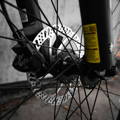Hydraulic brakes greatly enhance bike performance, offering precise braking and handling high speeds— especially valued by competitive road cyclists, mountain bikers, and e-Bikers that ride fast or have a heavy bike.
How to Adjust Brakes on an E-Bike?
Written by: Rémy Rossi | May 26, 2025 | Time to read 6 min
Brakes are a crucial safety feature and your e-Bike’s most important performance tool. Learn how to spot issues early and make simple adjustments that keep every ride smooth, safe, and responsive.

More about the Author: Remy Rossi
Rémy Rossi is a bike writer, mechanic, and educator who got his start in community-based bike shops and co-ops. With a decade in the industry, he still wrenches on bikes when he can and plays bike polo on a fixie.

Ensuring that electric bikes are equipped with well-functioning brakes is essential for safety. Brakes are crucial for controlling the speed and maneuverability of e-Bikes and a rider's confidence on the road.
Whether riding mountain e-Bikes designed for hilly terrain or road electric bikes, understanding the difference between hydraulic and mechanical brakes, plus knowing how to tighten your brakes, is right up there with the most important bits of e-Bike knowledge for all riders.
Understanding electric bike brakes

How to know when your brakes need tightening

- Spongy brake lever: If your brake lever feels soft or spongy when squeezed, it may mean your brakes need tightening or a brake bleed.
- Increased lever travel: If you need to pull the brake lever further than usual before the disc brake pads engage, it's a sign that adjustment is necessary. This could indicate a loose or damaged brake cable or trapped air bubbles in the hydraulic system.
- Excessive brake pad wear: If the brake pads are wearing down unevenly or have become thin, it's time to adjust the brakes. Typically, 1 mm or less in thickness indicates you need to replace the pads and readjust the brakes.
- Reduced stopping power: If you experience a noticeable decrease in your bike's stopping power, it could mean loose brakes. For example, stopping takes much longer or requires an extended distance.
- Brake rubbing or dragging: If you hear or feel rubbing or dragging when pedaling, it suggests that the brakes are not properly adjusted. It may be time to assess their condition and tighten accordingly, or adjust the rotor.
Maintain your brakes for optimal performance
Mechanical disc brakes

Hydraulic disc brakes

Premium e-Bikes at Upway
If you're in the market for a new e-Bike with excellent brakes, check out our selection at Upway. We offer a range of used electric bikes, including renowned brands like Aventon and Trek electric bikes, with most models featuring hydraulic brakes.
Whether you're a daily commuter, an adventure seeker, or simply looking for a leisurely ride, Upway has the perfect e-Bike to suit your needs. Explore our collection of affordable electric bikes and start your next cycling adventure with confidence!
Frequently Asked Questions
Are hydraulic brakes worth the extra cost?
How often should I bleed the brakes on my e-Bike?
You should bleed hydraulic brakes only when performance declines, like if they feel squishy or lever pull is too long. While some recommend bleeding every season, many riders go much longer without needing it. Mountain and e-Bike riders may need it more often due to heavier braking.
Can I upgrade from mechanical to hydraulic disc brakes?
Yes, mechanical disc brakes can be upgraded to hydraulic, but you’ll need a full hydraulic brakeset—calipers, levers, and housing—as the parts aren’t interchangeable. This upgrade can greatly improve performance, especially on bikes like electric mountain bikes.
Key Takeaways
- Recognize when brakes need attention: Signs include spongy levers, reduced stopping power, or brake rubbing.
- Adjust based on your brake type: Mechanical brakes are easier to tighten, while hydraulic systems may require professional bleeding.
- Regular brake checks matter: Inspect every few months or after heavy use to ensure safety and responsiveness when you ride.


